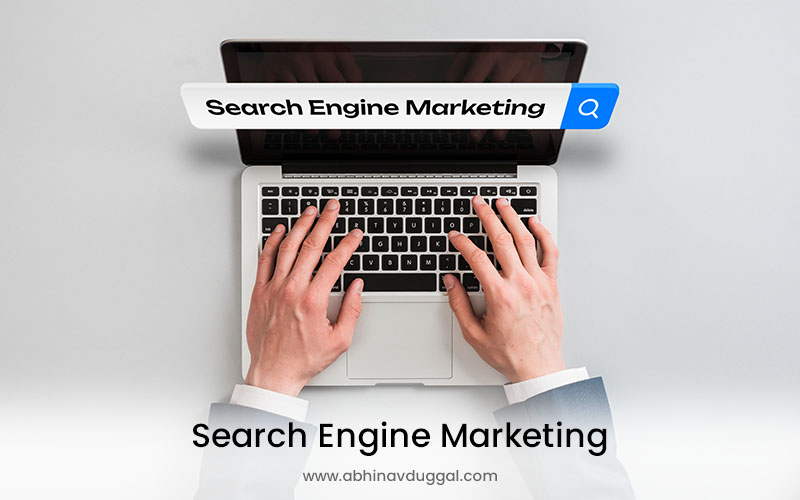Search Engine Marketing

Search Engine Marketing also known as SEM is a digital marketing technique that helps businesses promote their websites through paid advertisements on search engines like Google Bing and Yahoo. SEM allows businesses to reach their target audience instantly and drive traffic to their website. Unlike SEO which focuses on organic traffic SEM is a paid strategy that provides immediate visibility. Businesses of all sizes use SEM to increase leads sales and brand awareness.
What is Search Engine Marketing
Search Engine Marketing is the process of using paid ads on search engines to promote products or services. These ads appear on the top or bottom of search results when people search for related keywords. SEM works on a pay-per-click PPC model where businesses pay only when someone clicks on their ad. This makes SEM a cost-effective method to reach potential customers who are already interested in what you offer.
Importance of SEM
SEM is important because it provides instant visibility in a competitive market. Many users click on paid ads because they appear on top of search results. SEM also complements SEO by helping businesses reach the audience while SEO takes time to show results. It allows precise targeting and measurable results which makes it easier to track ROI.
Benefits of SEM
Immediate visibility on search engines
Targeted audience based on keywords location and device
Measurable results with analytics
Flexible budget options for businesses of any size
Complementary to SEO for better overall online presence
Increase in website traffic leads and sales
Components of SEM
Pay-Per-Click Advertising PPC
PPC is the core component of SEM. Businesses create ads and bid on specific keywords. Every time a user clicks on the ad the business pays the bid amount. Popular platforms for PPC include Google Ads and Bing Ads.
Keyword Research
Keyword research is essential for SEM campaigns. It involves finding the right keywords that potential customers are searching for. Using relevant keywords ensures that ads reach the correct audience.
Ad Copywriting
Writing effective ad copy is crucial in SEM. The ad must be attractive clear and include a call to action. Good ad copy increases the chances of clicks and conversions.
Landing Page Optimization
After clicking the ad users land on a page designed to convert them into customers. A well-optimized landing page improves user experience and increases conversions.
Bid Management
Managing bids is important to maximize ROI. Businesses can set daily budgets, adjust bids for competitive keywords, and use automated tools to optimize performance.
Types of SEM Ads
Search Ads
These are text ads that appear on the search engine results page when users search for specific keywords. They are the most common type of SEM ad.
Display Ads
Display ads are visual banners shown on websites within the Google Display Network. They help in brand awareness and retargeting users who have visited your site.
Shopping Ads
Shopping ads showcase products directly in search results with images, prices, and store names. They are effective for e-commerce businesses.
Remarketing Ads
Remarketing ads target users who have previously visited your website. These ads remind them of your products or services and encourage them to return and convert.
SEM Strategies
Target the Right Audience
Use tools to select keywords that match user intent. Targeting the right audience ensures that ads reach people likely to buy your product.
Optimize Ad Copies
Write clear and attractive ads with strong call-to-action phrases. A well-written ad increases click-through rates and conversions.
Use Negative Keywords
Negative keywords prevent ads from showing for irrelevant searches. This reduces wasted clicks and improves ROI.
Track Performance
Use analytics tools to monitor campaign performance. Track metrics like CTR, conversion rate, and cost per click to improve campaigns continuously.
A/B Testing
Test multiple versions of ads to see which performs better. A/B testing helps optimize campaigns and get maximum results.
Advantages of SEM
Fast results compared to SEO
Highly targeted audience reach
Measurable and trackable outcomes
Flexible budget and bidding options
Complements organic marketing strategies
Improves brand visibility and awareness
Challenges in SEM
High competition for popular keywords
Requires continuous monitoring and adjustments
Costs can rise if not managed properly
Ad fatigue may occur if campaigns are not refreshed
Requires knowledge of analytics and bid management
Future of SEM
The future of SEM includes AI-based targeting, voice search optimization, and automation. Businesses will be able to target users more precisely and reduce costs. Video ads and interactive content will become more popular as user engagement increases. SEM combined with SEO and social media will form a comprehensive digital marketing strategy for long-term success.
SEM for Small Businesses
Small businesses can benefit from SEM by targeting local keywords and setting manageable budgets. Local search ads help businesses attract nearby customers. Even with limited resources small businesses can compete with larger companies using effective SEM strategies.
Conclusion
Search Engine Marketing is a powerful tool for businesses to gain immediate online visibility. With proper keyword research, effective ad copy, optimized landing pages, and continuous monitoring, SEM can deliver high traffic leads and conversions. In today’s competitive digital world SEM is essential for businesses looking to grow and reach the right audience quickly and efficiently.
Why Customers Loves Us?

15+ Years Of Experience In Digital Industry
With over a decade of hands-on experience, we’ve helped businesses across industries thrive in the digital space. Our expertise ensures strategic, results-driven solutions tailored to your unique goals.

Guaranteed Results

Skilled Professional

Excellent Customer Support

Powerful Tools

Confidential Agreement









